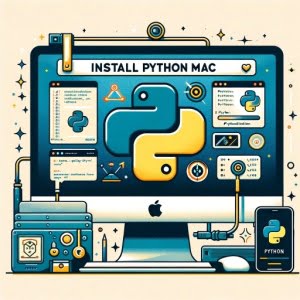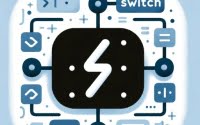How to Install Python on a Mac: Step-by-Step

Looking to install Python on your Mac but not sure where to start? Just like setting up a new appliance, installing Python can be a breeze with the right instructions.
Whether you’re a coding novice or a seasoned programmer new to Mac, this guide is designed to help you get Python up and running on your Mac. We’ll take you through the process, from downloading Python from the official website to running the installer and setting up your Python environment.
So let’s dive in and get started with Python on your Mac!
TL;DR: How Do I Install Python on a Mac?
To install Python on a Mac, you need to download the latest version from the official Python website and run the installer. Here’s a simple example of how you might do this:
# Navigate to the Python downloads page
open https://www.python.org/downloads/
# Download the latest Python version (replace 'x.x.x' with the version number)
curl -O https://www.python.org/ftp/python/x.x.x/python-x.x.x-macosx10.9.pkg
# Run the installer
open python-x.x.x-macosx10.9.pkg
# Output:
# This will open the Python installer
In this example, we first navigate to the Python downloads page. Then, we download the latest Python version by replacing ‘x.x.x’ with the version number. Finally, we run the installer which opens the Python installer.
This is a basic way to install Python on a Mac, but there’s much more to learn about the installation process. Continue reading for a more detailed guide and advanced usage scenarios.
Table of Contents
- Easy Python Installation for Beginners
- Verifying Your Python Installation
- Setting Up Environment Variables
- Updating Python to a Newer Version
- Installing Python with Homebrew
- Installing Python with Anaconda
- Comparing Methods
- Troubleshooting Common Python Installation Issues
- Understanding Python: A Powerful Language
- The Importance of Correct Python Installation
- Python’s Capabilities After Installation
- Journey Beyond Installation: Python’s World of Opportunities
- Wrapping Up: Installing Python on Mac
Easy Python Installation for Beginners
Installing Python on a Mac is straightforward. Here’s a step-by-step guide to help you get started.
Step 1: Download Python
First, navigate to the Python downloads page. You can do this in your web browser or via the command line. Here’s how you can do it using the command line:
# Navigate to the Python downloads page
open https://www.python.org/downloads/
# Output:
# This will open the Python downloads page in your default web browser
Once the downloads page is open, click on the latest Python release to download the .pkg file.
Step 2: Run the Installer
After the .pkg file has downloaded, you can run the installer. Here’s how you do it:
# Run the installer (replace 'x.x.x' with the version number you downloaded)
open python-x.x.x-macosx10.9.pkg
# Output:
# This will open the Python installer
Follow the installer’s prompts to complete the installation.
And that’s it! You’ve installed Python on your Mac. In the next section, we’ll discuss how to verify your Python installation and set up your Python environment.
Verifying Your Python Installation
After installing Python on your Mac, it’s important to verify that the installation was successful. You can do this by running a simple command in your terminal:
# Check Python version
python --version
# Output:
# Python x.x.x
This command should return the version of Python that you just installed. If it does, congratulations! Your Python installation was successful.
Setting Up Environment Variables
Next, you might want to set up your Python environment variables. This can help your system locate Python and any associated tools more easily. Here’s how you can do it:
# Add Python to PATH (replace 'x.x.x' with your Python version)
echo 'export PATH="/Library/Frameworks/Python.framework/Versions/x.x.x/bin:${PATH}"' >> ~/.bash_profile
# Apply the changes
source ~/.bash_profile
# Output:
# This will add Python to your PATH and apply the changes to your current session
Updating Python to a Newer Version
Python is frequently updated with new features and bug fixes. Therefore, it’s a good idea to keep your Python installation up to date. Here’s how you can update Python on your Mac:
# Check for Python updates
python -m pip install --upgrade pip
# Output:
# Requirement already up-to-date: pip in /Library/Frameworks/Python.framework/Versions/x.x.x/lib/pythonx.x/site-packages (x.x.x)
This command will check for any available updates and install them. If your Python is already up to date, it will let you know.
Installing Python with Homebrew
Homebrew is a popular package manager for macOS that can make installing Python even easier. Here’s how you can do it:
# Install Homebrew (if not already installed)
/bin/bash -c "$(curl -fsSL https://raw.githubusercontent.com/Homebrew/install/HEAD/install.sh)"
# Install Python with Homebrew
brew install python
# Output:
# This will install Python using Homebrew
This will install the latest version of Python on your Mac using Homebrew. You can check the installed version using the python --version command.
Installing Python with Anaconda
Anaconda is a free and open-source distribution of Python and R programming languages for scientific computing. Here’s how you can install Python using Anaconda:
# Navigate to the Anaconda downloads page
open https://www.anaconda.com/products/distribution
# Download Anaconda (replace 'x.x.x' with the version number)
curl -O https://repo.anaconda.com/archive/Anaconda3-x.x.x-MacOSX-x86_64.sh
# Run the installer
bash Anaconda3-x.x.x-MacOSX-x86_64.sh
# Output:
# This will open the Anaconda installer
After running the installer, follow the prompts to complete the installation. Once installed, you can verify the installation by checking the Python version (python --version).
Comparing Methods
Each method has its pros and cons. The basic installation method is straightforward and suitable for beginners. Homebrew is a handy tool that can manage all your packages, not just Python. Anaconda is particularly useful for scientific computing and data science due to its additional packages and tools. Choose the method that best suits your needs.
Troubleshooting Common Python Installation Issues
Even with the best guide, you may encounter some bumps in the road when installing Python on your Mac. Here, we address some of the common issues and their solutions.
‘Command Not Found’ Errors
If you encounter a ‘command not found’ error after installation, it’s likely that Python isn’t in your system’s PATH. Here’s how you can add it:
# Add Python to PATH (replace 'x.x.x' with your Python version)
echo 'export PATH="/Library/Frameworks/Python.framework/Versions/x.x.x/bin:${PATH}"' >> ~/.bash_profile
# Apply the changes
source ~/.bash_profile
# Output:
# This will add Python to your PATH and apply the changes to your current session
After running these commands, try checking your Python version again (python --version). If Python is correctly installed and in your PATH, you should see the version you installed.
Issues with Permissions
If you encounter permission issues during installation, it might be because you don’t have the necessary administrative rights. In this case, you can try using sudo to run the installer:
# Run the installer with sudo (replace 'x.x.x' with the version number you downloaded)
sudo open python-x.x.x-macosx10.9.pkg
# Output:
# This will open the Python installer with administrative privileges
Enter your password when prompted. This gives the installer the permissions it needs to install Python on your system.
Remember, it’s important to understand the implications of using sudo before you use it. Always be sure you trust the software you’re installing.
Understanding Python: A Powerful Language
Python is a high-level, interpreted programming language that has gained popularity due to its readability and simplicity. It’s versatile, making it a great choice for a variety of projects from web and software development to data analysis, machine learning, and scientific computing.
The Importance of Correct Python Installation
Correct installation of Python on your Mac is crucial. It ensures that Python and its associated tools and libraries function as expected. It also allows you to manage and update Python versions more effectively, which is important as Python is regularly updated with new features and bug fixes.
Python’s Capabilities After Installation
Once Python is installed, the possibilities are endless. You can start by experimenting with Python’s interactive shell. Try running a simple Python command:
print('Hello, Python!')
# Output:
# 'Hello, Python!'
This command prints the string ‘Hello, Python!’ to the console. It’s a simple demonstration of Python’s functionality.
From here, you can move on to more complex tasks. You can write scripts to automate tasks, develop web applications, analyze data, and much more. You can also install additional Python packages to extend Python’s functionality. For example, you might install Django to help with web development, or pandas for data analysis.
In short, installing Python on your Mac opens the door to a wide range of programming opportunities. It’s the first step on your journey with this powerful and versatile language.
Journey Beyond Installation: Python’s World of Opportunities
Once Python is installed on your Mac, a world of opportunities opens up. Here are a few things you can do after installing Python.
Setting Up a Virtual Environment
One of the first things you might want to do is set up a virtual environment. This allows you to create an isolated environment for your Python projects, preventing any conflicts between different versions of Python and its libraries. Here’s how you can do it:
# Install the virtualenv package
pip install virtualenv
# Create a virtual environment (replace 'myenv' with your environment name)
virtualenv myenv
# Activate the virtual environment
source myenv/bin/activate
# Output:
# (myenv)
This creates a new virtual environment named ‘myenv’ and activates it. The (myenv) before your prompt indicates that the virtual environment is active.
Installing Additional Python Packages
Python’s functionality can be extended with additional packages. For example, you might install Flask for web development, or NumPy for numerical computations. Here’s how you can install packages using pip, Python’s package installer:
# Install a package (replace 'package-name' with the name of the package)
pip install package-name
# Output:
# Successfully installed package-name-x.x.x
This installs the specified package and its dependencies.
Further Resources for Python Proficiency
To continue your Python journey, here are some resources that might help:
- Installing Python on Ubuntu: Tips and Tricks – Discover the benefits of having Python readily available on your Ubuntu machine.
Best Practices for Updating Your Installation – Master the art of keeping Python current with updates to boost performance and security.
An In-Depth Look at Python Wheels – Dive into the world of Python packaging and explore how to simplify Python packaging with wheels.
Python’s Official Documentation – A comprehensive resource with tutorials, library references, and more.
Real Python offers Python tutorials, articles, and other resources.
Python for Beginners provides a wide range of Python tutorials suitable for beginners.
These resources can help you learn more about Python, its libraries, and its applications. Remember, the journey of learning Python is a marathon, not a sprint. Happy coding!
Wrapping Up: Installing Python on Mac
In this guide, we’ve covered the process of installing Python on a Mac, starting from downloading Python from the official website to running the installer and verifying the installation.
We’ve also discussed setting up environment variables and updating Python to a newer version. For more advanced users, we explored alternative methods of installation using package managers like Homebrew and Anaconda.
Along the way, we’ve addressed common issues such as ‘command not found’ errors and permissions issues, providing solutions to ensure a smooth installation process. We highlighted the importance of correct Python installation and the exciting possibilities that open up once Python is correctly installed on your Mac.
Here’s a quick comparison of the methods we discussed:
| Method | Difficulty Level | Suitable For |
|---|---|---|
| Basic Installation | Beginner | Anyone new to Python or programming |
| Homebrew | Intermediate | Users comfortable with command line and package management |
| Anaconda | Expert | Users focused on scientific computing and data science |
Remember, the journey doesn’t end with installation. We’ve also discussed how to set up a virtual environment, install additional Python packages, and provided resources for further learning.
Whether you’re a beginner stepping into the world of programming or a seasoned coder exploring Python, we hope this guide has been a helpful companion on your Python journey.

